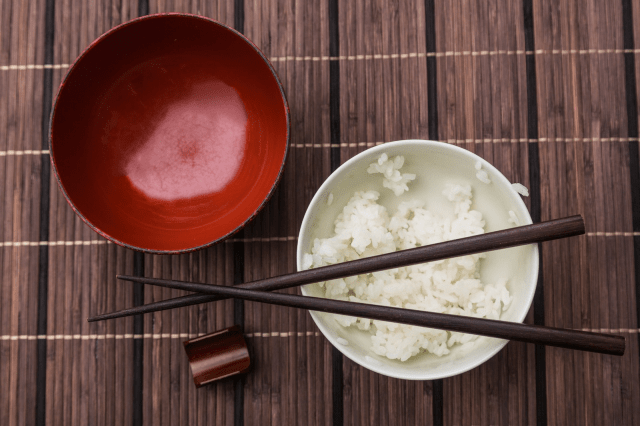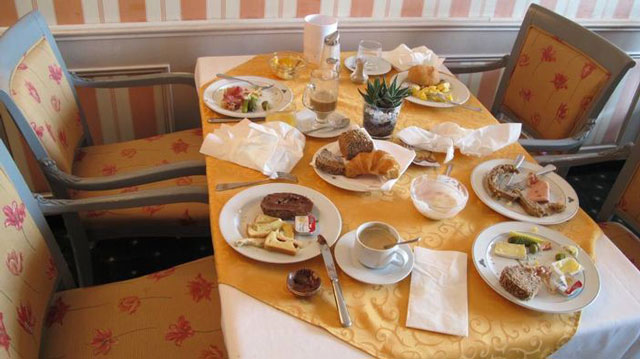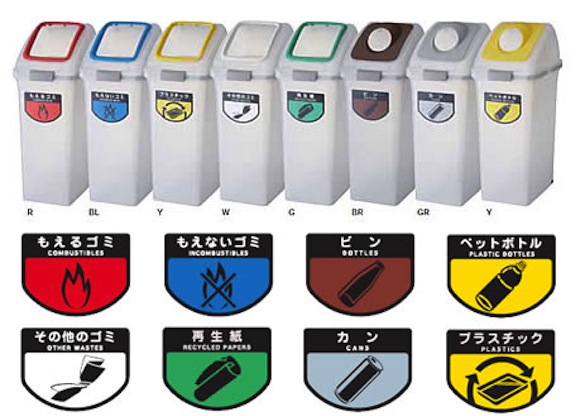In the past few months the Japanese word mottainai, which conveys a sense of regret over waste, has begun to spread into the Western world, and the concept of mottainai can be seen most clearly in every bowl of rice.
waste
As a child, did your parents ever try to get you to finish everything on your plate by telling you how there are starving children in the world who aren’t lucky enough to have the luxury of a decent meal? As a kid, it probably just seemed like an unfair guilt-trip, but as adults hopefully we have all now realized the truth behind those words and the importance of not being wasteful.
A particular Swiss hotel has taken similar tactics to curb the wastefulness of its guests at the breakfast buffet, after shameful amounts of food have been left partially or wholly uneaten and then thrown away. But the hotel took it a step further by including shocking photos to help drive the message home.
Is Japan’s recycling system the most complicated in the world? It sure feels like it sometimes. Household waste must of course be separated into burnable and non-burnable, but after that there’s a dizzying array of recycling categories to break your non-burnables into. Since Japan is a relatively small country without masses of land to use for burying waste, the vast majority of waste used to be incinerated. However, with increasing ecological awareness in the 1990s came new legislation to minimise the amount of waste being burnt, and promote recycling.
Public awareness of the need to recycle is high, but the system can be baffling for new foreign residents. The problem lies not only in the array of recycling categories, but also in the apparent overlap between them: the grey areas. Is an empty pizza box considered recycled paper? Or is it burnable? Paper packages? “Other”? And if a bottle is made of a different type of plastic to the standard PET, is still a “pet bottle”, or is it just “plastic”?
Today we bring you six reasons to learn what goes in what box, and a few hints for getting it right along the way.



 McDonald’s new Happy Meals offer up cute and practical Sanrio lifestyle goods
McDonald’s new Happy Meals offer up cute and practical Sanrio lifestyle goods Studio Ghibli glasses cases let anime characters keep an eye on your spectacles
Studio Ghibli glasses cases let anime characters keep an eye on your spectacles All-you-can-drink Starbucks and amazing views part of Tokyo’s new 170 meter-high sky lounge
All-you-can-drink Starbucks and amazing views part of Tokyo’s new 170 meter-high sky lounge Super Nintendo World expansion gets delayed for several months at Universal Studios Japan
Super Nintendo World expansion gets delayed for several months at Universal Studios Japan Kyoto’s 100 Demons yokai monster parade returns!
Kyoto’s 100 Demons yokai monster parade returns! Beautiful Sailor Moon manhole cover coasters being given out for free by Tokyo tourist center
Beautiful Sailor Moon manhole cover coasters being given out for free by Tokyo tourist center More foreign tourists than ever before in history visited Japan last month
More foreign tourists than ever before in history visited Japan last month Why women think Tom Hiddleston is the ideal man, according to Japanese Twitter
Why women think Tom Hiddleston is the ideal man, according to Japanese Twitter The oldest tunnel in Japan is believed to be haunted, and strange things happen when we go there
The oldest tunnel in Japan is believed to be haunted, and strange things happen when we go there Poseable North American Mega Man figure lets you admire the character’s belly in three dimensions
Poseable North American Mega Man figure lets you admire the character’s belly in three dimensions Disney princesses get official manga makeovers for Manga Princess Cafe opening in Tokyo
Disney princesses get official manga makeovers for Manga Princess Cafe opening in Tokyo Starbucks reopens at Shibuya Scramble Crossing with new look and design concept
Starbucks reopens at Shibuya Scramble Crossing with new look and design concept Beautiful new Final Fantasy T-shirt collection on the way from Uniqlo【Photos】
Beautiful new Final Fantasy T-shirt collection on the way from Uniqlo【Photos】 Is the new Shinkansen Train Desk ticket worth it?
Is the new Shinkansen Train Desk ticket worth it? Foreign English teachers in Japan pick their favorite Japanese-language phrases【Survey】
Foreign English teachers in Japan pick their favorite Japanese-language phrases【Survey】 Japanese convenience store packs a whole bento into an onigiri rice ball
Japanese convenience store packs a whole bento into an onigiri rice ball We try out “Chan Ramen”, an underground type of ramen popular in the ramen community
We try out “Chan Ramen”, an underground type of ramen popular in the ramen community Studio Ghibli releases Kiki’s Delivery Service chocolate cake pouches in Japan
Studio Ghibli releases Kiki’s Delivery Service chocolate cake pouches in Japan Japan’s bone-breaking and record-breaking roller coaster is permanently shutting down
Japan’s bone-breaking and record-breaking roller coaster is permanently shutting down New definition of “Japanese whiskey” goes into effect to prevent fakes from fooling overseas buyers
New definition of “Japanese whiskey” goes into effect to prevent fakes from fooling overseas buyers Our Japanese reporter visits Costco in the U.S., finds super American and very Japanese things
Our Japanese reporter visits Costco in the U.S., finds super American and very Japanese things Studio Ghibli unveils Mother’s Day gift set that captures the love in My Neighbour Totoro
Studio Ghibli unveils Mother’s Day gift set that captures the love in My Neighbour Totoro Foreign passenger shoves conductor on one of the last full runs for Japan’s Thunderbird train
Foreign passenger shoves conductor on one of the last full runs for Japan’s Thunderbird train Domino’s Japan now sells…pizza ears?
Domino’s Japan now sells…pizza ears? New Japanese KitKat flavour stars Sanrio characters, including Hello Kitty
New Japanese KitKat flavour stars Sanrio characters, including Hello Kitty Kyoto creates new for-tourist buses to address overtourism with higher prices, faster rides
Kyoto creates new for-tourist buses to address overtourism with higher prices, faster rides Sales of Japan’s most convenient train ticket/shopping payment cards suspended indefinitely
Sales of Japan’s most convenient train ticket/shopping payment cards suspended indefinitely Sold-out Studio Ghibli desktop humidifiers are back so Totoro can help you through the dry season
Sold-out Studio Ghibli desktop humidifiers are back so Totoro can help you through the dry season Japanese government to make first change to romanization spelling rules since the 1950s
Japanese government to make first change to romanization spelling rules since the 1950s Ghibli founders Toshio Suzuki and Hayao Miyazaki contribute to Japanese whisky Totoro label design
Ghibli founders Toshio Suzuki and Hayao Miyazaki contribute to Japanese whisky Totoro label design Doraemon found buried at sea as scene from 1993 anime becomes real life【Photos】
Doraemon found buried at sea as scene from 1993 anime becomes real life【Photos】 Tokyo’s most famous Starbucks is closed
Tokyo’s most famous Starbucks is closed One Piece characters’ nationalities revealed, but fans have mixed opinions
One Piece characters’ nationalities revealed, but fans have mixed opinions We asked a Uniqlo employee what four things we should buy and their suggestions didn’t disappoint
We asked a Uniqlo employee what four things we should buy and their suggestions didn’t disappoint Princesses, fruits, and blacksmiths: Study reveals the 30 most unusual family names in Japan
Princesses, fruits, and blacksmiths: Study reveals the 30 most unusual family names in Japan Beautiful Sailor Moon manhole cover coasters being given out for free by Tokyo tourist center
Beautiful Sailor Moon manhole cover coasters being given out for free by Tokyo tourist center More foreign tourists than ever before in history visited Japan last month
More foreign tourists than ever before in history visited Japan last month Why women think Tom Hiddleston is the ideal man, according to Japanese Twitter
Why women think Tom Hiddleston is the ideal man, according to Japanese Twitter The oldest tunnel in Japan is believed to be haunted, and strange things happen when we go there
The oldest tunnel in Japan is believed to be haunted, and strange things happen when we go there Poseable North American Mega Man figure lets you admire the character’s belly in three dimensions
Poseable North American Mega Man figure lets you admire the character’s belly in three dimensions Gacha capsule machines now dispense perfumes in Japan
Gacha capsule machines now dispense perfumes in Japan Constipated cats, sticky blue poop and more: Japan’s 9 weirdest vending machine toys
Constipated cats, sticky blue poop and more: Japan’s 9 weirdest vending machine toys Disney princesses get official manga makeovers for Manga Princess Cafe opening in Tokyo
Disney princesses get official manga makeovers for Manga Princess Cafe opening in Tokyo Studio Ghibli bath mats and towels will help wash your worries away
Studio Ghibli bath mats and towels will help wash your worries away Is Japan’s massive Shizuoka steak sandwich really as delicious as it looks in promo photos?
Is Japan’s massive Shizuoka steak sandwich really as delicious as it looks in promo photos? Why do I look normal in my home mirror, but hideous when I catch my reflection in a window?
Why do I look normal in my home mirror, but hideous when I catch my reflection in a window? The Fake Burger is now on the menu at Burger King Japan, but is it worth the hype?
The Fake Burger is now on the menu at Burger King Japan, but is it worth the hype?